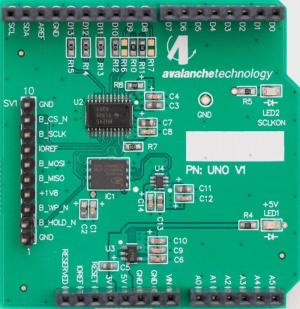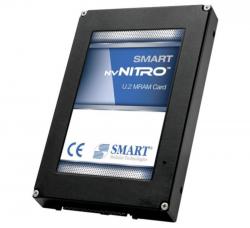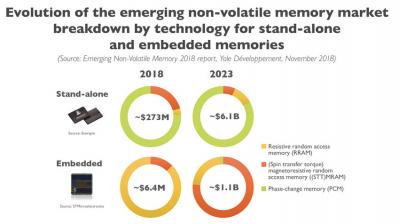STT-MRAM: Introduction and market status - Page 7
Yole Developpement sees STT-MRAM leading the embedded emerging-NVM market
Market analyst firm Yole Developpement presents its latest next-generation memory forecasts in an interesting new article. The company says that following more than 15 years of development, PCM is finally taking off in stand-alone applications due to strong support from Intel and Micron.
STT-MRAM is expected to lead the embedded memory race as many foundries are rushing to add MRAM support and expertise to their product lines. STT-MRAM is promising for enterprise storage SCM.
IMEC: STT-MRAM is suitable for 5 nm last level cache, offers significant energy gains over SRAM in large memory densities
Researchers at Belgium-based research institute Imec presented the first power-performance area comparison between SRAM and STT-MRAM last-level cache at the 5 nm node.
The analysis, based on design-technology co-optimization and silicon verified models, reveals that STT-MRAM meets the performance requirements for last-level caches in the high-performance computing domain. For larger memory densities, STT-MRAM was found to offer significant energy gains compared to SRAM.
Avalanche Technology announces its 2nd-generation pMTJ STT-MRAM chips at 1-32 Mb densities
pMTJ STT-MRAM developer Avalanche Technology announced its 2nd-generation serial non-volatile discrete MRAM memory family. The SPnvSRAM family offers 1 Mb to 32 Mb densities at extended-temperature industrial-grade specifications. Avalanche says that these devices, available in low pin count, small package options, are ideal for a broad range of industrial, automotive and consumer applications.

Avalanche's 2-Gen SPnvSRAM is offered in 108-MHz Quad Serial Peripheral Interface (QSPI) performance as a byte addressable memory thus eliminating the need for software device drivers.
SMART Modular Technology launces aMRAM-enhanced n nvNITRO U.2 Sotrage Accelerator
SMART Modular Technologies has launched its new nvNITRO U.2 Storage Accelerator that features Everspin's STT-MRAM technology. The nvNITRO is ideally suited for synchronous logging applications such as those used for financial trading.

SMART's nvNITRO U.2 Storage Accelerator uses a standard NVMe interface that is 1.2.1 compliant and provides less than six microseconds of industry-leading low latency access with persistence so that all logging data is safe. The U.2 form factor brings with it the advantage of being hot-swappable.
Coughlin: MRAM and STT-MRAM revenues will reach $3.3 billion by 2028
Tom Coughlin posted an interesting overview of the 2018 MRAM Developer day, which is well worth a read. Besides the conference report, Coughlin also updates on its market estimates - the market for MRAM and STT-MRAM memory solutions will experience fast growth - growing from $36 million in 2017 to about $3.3 billion in 2028. This growth will be at the expense of SRAM, NOR flash and some DRAM.

The demand for MRAM memory will result in an increased demand for MRAM production equipment, of course. MRAM equipment revenues will reach $792 million by 2028, according to Coughlin Associates.
Researchers develop a sub 10-nm STT MTJ
Researchers from UC Berkeley and the Huazhong University of Science and Technology developed sub 10-nm STT MTJs that shows a thermal stability factor of more than 80.
The reserachers say that the highly efficient and dense MTJ could lead to higher efficiency and density STT-MRAM devices and spin-based computers.
IBM introduces its latest 19.2TB enterprise SSD drivers with Everspin's STT-MRAM
A couple of days ago, Everdisplay disclosed its first major design win with a "top enterprise storage vendor" for its 40nm 256Mb STT-MRAM chips. We now know that this vendor is IBM - as it introduced its latest-generation enterprise SSD FlashSystem, which indeed includes Everspin's STT-MRAM.

Using MRAM instead of DRAM memory enabled IBM to remove the relatively large supercapacitors (used to make the DRAM non-volatile) and so the company was able to reduced the size of its drives and switch to a standard 2.5-inch U.2 drive form factor. The new FlashSystem SSDs support up to 19.2TB of 64L 3D TLC NAND. IBM's system uses a 20-channel NAND interface and a four-lane PCIe 4.0 host interface that can operate in dual-port 2+2 mode.
Everspin announces its first major design win with a top enterprise storage vendor for its 256Mb STT-MRAM chips
Everspin announced that it will demonstrate its latest MRAM technologies at the Flash Memory Summit 2018 which starts today.

In its PR, Everdisplay discloses its first major design win with a "top enterprise storage vendor" for its 40nm 256Mb STT-MRAM chips. Everspin says that MRAM enabled the vendor to achieves new levels of performance, storage capacity and reliability.
Multi-layered Co/Ni films are highly desirable materials for effective spin transfer torque
Researchers from the University of Lorraine in France have discovered that multilayers films made of cobalt (Co) and nickel (Ni) hold great promise for STT-MRAM applications.

It was already shown before that Co/Ni multilayers have very good properties for spintronics applications, but up until now it wasn't clear if the films have a sufficiently large intrinsic spin polarization, which is necessary to create and maintain spin-polarized currents in spintronic devices. It was now shown that the films have a spin polarization of about 90% - which is similar to the best spintronic materials.
Veeco is encouraged by interest in its STT-MRAM ion beam etch systems
Veeco says that it in the past quarter it has received Ion Beam Etch Solution orders from STT-MRAM developers. Veeco's systems are used for magnetic memory development, and the company is collaborating with a leading semiconductor capital equipment manufacturer in this market.

The company "continues to be encouraged by our customers interest" in the STT-MRAM market.
Pagination
- Previous page
- Page 7
- Next page




